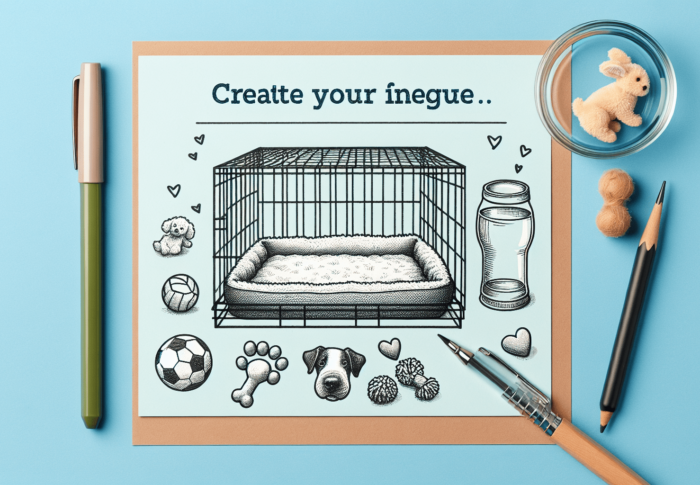
How to Successfully Crate Train An Anxious Dog
Crate training can be a valuable tool for helping anxious dogs feel more secure and comfortable. Whether you are bringing home a new pup or working with an adult dog struggling with anxiety, crate training can provide them with a safe space to retreat to when they feel overwhelmed. By following a few simple steps and providing positive reinforcement, you can help your anxious dog see their crate as a place of solace and security. In this article, we will explore the ins and outs of crate training for anxious dogs, sharing tips and techniques to set your furry friend up for success.

This image is property of images.pexels.com.
Find products like these on Amazon!
Understanding Anxiety in Dogs
Anxiety in dogs is a common issue that many pet owners face. It’s important to recognize the signs of anxiety in your furry friend so that you can address the issue and provide them with the support they need. Some of the signs of anxiety in dogs include pacing, panting, excessive drooling, trembling, whining, and destructive behavior. If you notice any of these signs in your dog, it’s essential to understand the underlying causes and triggers of their anxiety.
Recognizing Anxiety Signs
When it comes to recognizing anxiety signs in your dog, it’s important to pay attention to their behavior and body language. Look for signs of restlessness, such as excessive pacing or inability to settle down. Notice if your dog shows signs of distress, such as heavy panting, drooling, or trembling. Observe any changes in their eating or drinking habits, as well as any unusual behaviors like excessive barking or hiding. By being aware of these signs, you can better understand your dog’s anxiety and provide the necessary support.
Find products like these on Amazon!
Identifying Triggers
Identifying the triggers of your dog’s anxiety is crucial to addressing their anxiety effectively. Triggers can vary from dog to dog, but some common ones include loud noises like thunderstorms or fireworks, being left alone, unfamiliar environments or people, and certain medical conditions. By identifying the specific triggers that cause your dog’s anxiety, you can take steps to minimize their exposure to these triggers and provide them with a more comfortable and anxiety-free environment.
The Importance of Crate Training for Anxious Dogs
Crate training can be an effective tool in managing anxiety in dogs. When done properly, crate training provides a safe and secure space for your dog to retreat to when they’re feeling anxious. It can also help prevent destructive behavior and ensure their safety when you cannot supervise them. However, it’s crucial to approach crate training with a focus on positive reinforcement and gradual exposure to the crate. Let’s explore the steps to prepare for crate training an anxious dog.

This image is property of images.pexels.com.
Preparing for Crate Training
Before you begin crate training, it’s essential to choose the right crate for your anxious dog. Opt for a crate that is large enough for them to stand, turn around, and lie down comfortably. Consider whether a wire crate or a plastic crate would be more suitable for your furry friend’s needs. Once you have the right crate, it’s time to introduce it gradually to your dog.
Introducing the Crate Gradually
To help your anxious dog feel comfortable with the crate, it’s important to introduce it gradually. Start by placing the crate in a location where your dog spends a lot of time. Leave the crate door open and encourage your dog to explore the crate at their own pace. Make the crate a positive and inviting space by placing treats or toys inside. Allow your dog to enter and exit the crate freely, praising them for their curiosity and bravery.

This image is property of images.pexels.com.
Creating a Positive Association with the Crate
To create a positive association with the crate, it’s important to make it a place of comfort and relaxation for your anxious dog. You can achieve this by feeding your dog their meals inside the crate. By associating the crate with something positive like food, your dog will start to view it as a safe and pleasant place to be. Additionally, consider placing cozy bedding inside the crate to make it more comfortable and inviting for your dog.
Creating a Safe and Comfortable Environment
In addition to crate training, it’s important to create a safe and comfortable environment for your anxious dog. This includes selecting a suitable location for the crate, providing cozy bedding, and including familiar scents and toys.
Selecting a Suitable Location
When choosing a location for the crate, consider a quiet and low-traffic area of your home. This will help minimize external stimuli that could trigger your dog’s anxiety. Avoid placing the crate in areas with excessive noise or where your dog may feel isolated. The goal is to create a safe and peaceful environment where your dog feels secure.
Providing Cozy Bedding
Cozy bedding is essential to ensure your dog’s comfort while in the crate. Choose soft and comfortable bedding that your dog can curl up on. This will not only provide physical comfort but also contribute to creating a sense of security and relaxation for your anxious dog.
Including Familiar Scents and Toys
To make the crate even more inviting, consider placing familiar scents and toys inside. These can be items that your dog is familiar with and enjoys. The familiar scents and toys will help create a sense of familiarity and comfort, reducing anxiety in your dog.
Establishing a Routine
Establishing a routine is crucial for anxious dogs as it helps create a sense of structure and predictability. Consistency is key when it comes to managing anxiety in dogs, and a routine can significantly contribute to their overall well-being.
Consistency is Key
When establishing a routine for your anxious dog, consistency is key. Stick to a daily schedule for feeding, potty breaks, exercise, and playtime. This will help your dog feel secure and confident in their daily activities, reducing anxiety levels.
Setting Regular Meal and Potty Schedules
Having regular meal and potty schedules can help reduce anxiety by providing a predictable routine. Feed your dog at the same times each day, and establish a consistent schedule for taking them outside for bathroom breaks. By following a routine, your dog will know what to expect, which can alleviate their anxiety.
Incorporating Exercise and Playtime
Daily exercise and playtime are essential for dogs, especially those with anxiety. Regular exercise helps release pent-up energy and promotes mental stimulation, which can significantly reduce anxiety levels. Make sure to incorporate walks, play sessions, and interactive toys into your dog’s routine to keep their mind and body active.
Using Positive Reinforcement
Positive reinforcement is a powerful tool when it comes to crate training an anxious dog. By rewarding calm behavior and avoiding punishment or scolding, you can create a positive association with the crate and instill a sense of security in your dog.
Rewarding Calm Behavior
When your dog displays calm behavior around the crate, be quick to offer praise and rewards. This can be in the form of treats, verbal encouragement, or gentle petting. By rewarding your dog’s calm behavior, you reinforce the idea that the crate is a safe and positive space.
Avoiding Punishment or Scolding
It’s important to remember that punishment or scolding is not effective in crate training an anxious dog. This can increase their anxiety levels and create a negative association with the crate. Instead, focus on positive reinforcement and encourage your dog with patience, understanding, and rewards.
Implementing Clicker Training
Clicker training can be a useful technique to reinforce positive behavior during crate training. By using a clicker and treats, you can mark and reward your dog’s calm and desirable behaviors. The clicker serves as a sound cue that signifies a reward is coming, helping your dog associate the crate with positive experiences.
Gradual Crate Exposure
Crate exposure should be a gradual process for anxious dogs. It’s important to start with short, supervised periods of confinement and gradually increase the duration over time.
Short Initial Confinement Periods
Begin by confining your dog to the crate for short periods, such as five to ten minutes. Stay nearby and provide reassurance and positive reinforcement during this time. Gradually increase the duration based on your dog’s comfort level. The key is to make the experience as positive and stress-free as possible.
Increasing Duration Gradually
As your dog becomes more comfortable with short periods of confinement, gradually increase the duration. Add a few minutes to each session, always ensuring your dog remains calm and relaxed. The goal is to build their confidence and tolerance, making the crate a pleasant place for them to be.
Preventing Distress During Crate Time
To prevent distress during crate time, ensure your dog has access to their favorite toys, chews, or puzzle toys. These can provide mental stimulation and help distract them from any feelings of anxiety or confinement. Additionally, provide plenty of positive reinforcement and praise during and after each crate session to reinforce positive behavior.
Crate Training Techniques
Various crate training techniques can be implemented to help anxious dogs feel more comfortable and secure in their crate.
Feeding Meals in the Crate
One effective technique is to feed your dog their meals inside the crate. This not only helps create a positive association with the crate but also allows them to associate mealtime with their safe space. Start by placing their food bowl near the crate, gradually moving it inside. Eventually, your dog will feel comfortable eating their meals inside the crate.
Using Crate as a Safe Haven
Encourage your dog to view the crate as their safe haven by providing treats, toys, and cozy bedding inside. Teach them that entering the crate is always a positive experience. This will help them find comfort and security in their crate, especially during times of anxiety or stress.
Gradually Closing the Crate Door
Once your dog is comfortable spending time inside the crate with the door open, you can start gradually closing the crate door. Begin by closing the door for a few seconds, then gradually increase the duration. Always reward your dog with treats and praise for remaining calm and relaxed during this process. Remember to take it at their pace and never force the door closed if they show signs of distress.
Dealing with Separation Anxiety
Separation anxiety is a common issue for many anxious dogs. It’s important to address this issue with patience and understanding to help your dog feel more comfortable when left alone.
Gradual Desensitization to Absences
To help your dog overcome separation anxiety, gradual desensitization is key. Start by practicing short departures, such as stepping outside for a few seconds and returning. Gradually increase the duration of your absences, always ensuring your dog remains calm and comfortable. This process helps your dog learn that you will always return, reducing their anxiety when you are not around.
Using Interactive Toys or Puzzles
Interactive toys or puzzles can be an excellent distraction for dogs with separation anxiety. These toys can keep your dog mentally engaged and entertained while you are away. Consider filling a Kong toy with treats or using puzzle toys that require problem-solving. This can help redirect their focus and alleviate anxiety during your absence.
Seeking Professional Help if Needed
If your dog’s separation anxiety persists despite your best efforts, it may be beneficial to seek professional help. A veterinary behaviorist or certified dog trainer experienced in anxiety disorders can provide guidance and develop a customized treatment plan for your dog. They may recommend additional techniques or therapies to help manage your dog’s anxiety and improve their overall well-being.
Troubleshooting Common Challenges
During crate training, you may encounter some common challenges. It’s important to approach these challenges with patience and persistence to ensure the success of your dog’s crate training journey.
Whining or Barking in the Crate
Whining or barking in the crate can be an indication that your dog is feeling anxious or uncomfortable. Rather than giving in to their demands, it’s essential to remain consistent and not immediately release them from the crate. Wait for a moment of silence or a calm behavior before letting them out. This teaches your dog that quiet and calm behavior is rewarded.
Fear of Confinement or Crate Aversion
Some dogs may develop a fear of confinement or crate aversion, especially if they have had negative experiences in the past. If your dog shows signs of fear or aversion, it’s important to address their concerns with patience and positive reinforcement. Start by making the crate a positive and inviting space again by using treats and praise. Gradually reintroduce the crate, allowing your dog to explore and enter at their own pace.
Escaping Attempts and Destructive Behavior
If your dog attempts to escape the crate or exhibits destructive behavior, it’s crucial to address these issues promptly. Reinforce the crate doors and ensure they are securely closed. Consider using a crate cover to create a den-like environment that adds an extra layer of security. Additionally, provide mental stimulation through toys and interactive feeding puzzles to redirect their energy and prevent destructive behavior.
Ensuring Long-Term Success
Once your anxious dog is crate trained, it’s important to maintain a positive crate experience and continue monitoring their anxiety levels.
Maintaining a Positive Crate Experience
To maintain a positive crate experience, continue to provide treats, praise, and rewards whenever your dog enters or exits the crate calmly. Use the crate for relaxation and downtime, allowing your dog to retreat to their safe space whenever they feel the need. By consistently reinforcing positive associations with the crate, you will ensure its continued success as a tool for managing anxiety.
Regularly Assessing Anxiety Levels
Anxiety levels can change over time, and it’s important to regularly assess your dog’s anxiety levels. Keep an eye out for any changes in behavior or signs of anxiety. If you notice an increase in anxiety, consider whether any triggers have occurred or if there have been any changes in their routine or environment. When you are aware of your dog’s anxiety levels, you can take proactive steps to address their needs.
Seeking Ongoing Support if Necessary
If your dog’s anxiety persists or if you need additional guidance, don’t hesitate to seek ongoing support from a professional. Veterinary behaviorists, certified dog trainers, and support groups can provide valuable insights and assistance in managing your dog’s anxiety. Remember, you are not alone in this journey, and there are resources available to help you and your anxious dog thrive.
In conclusion, crate training an anxious dog requires patience, understanding, and a focus on positive reinforcement. By recognizing anxiety signs, identifying triggers, and providing a safe and comfortable environment, you can set the stage for successful crate training. Through gradual exposure, positive reinforcement, and troubleshooting common challenges, you can help your anxious dog find comfort and security in their crate. Remember to maintain a positive crate experience, regularly assess anxiety levels, and seek ongoing support if necessary. With dedication and love, you can support your anxious dog on their journey to a happier and more relaxed life.
Find products like these on Amazon!
- Understanding Anxiety in Dogs
- Recognizing Anxiety Signs
- Identifying Triggers
- The Importance of Crate Training for Anxious Dogs
- Preparing for Crate Training
- Introducing the Crate Gradually
- Creating a Positive Association with the Crate
- Creating a Safe and Comfortable Environment
- Establishing a Routine
- Using Positive Reinforcement
- Gradual Crate Exposure
- Crate Training Techniques
- Dealing with Separation Anxiety
- Troubleshooting Common Challenges
- Ensuring Long-Term Success







-
-
2 days
Tagged Dog care, Separation anxiety, tips and tricks